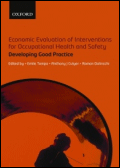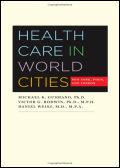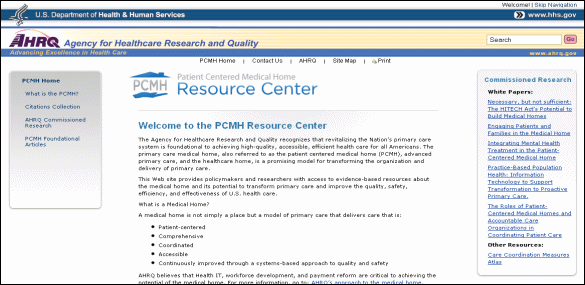LU POUR VOUS DE MARS 2011 : livres du mois - sites du mois - working papers
Tous les lu pour vous
LES LIVRES DU MOIS
Réduire les inégalités sociales en santé.
Potvin L., Moquet M.J., Jones C.M.
Saint Denis : Inpes : 2010 : 379 p.
Les inégalités sociales de santé ont tendance à s'accroître, y compris dans les pays d'Europe occidentale dont la France. Cet ouvrage est prioritairement destiné aux professionnels confrontés à ces inégalités, qu'ils travaillent dans la santé, l'éducation, le social ou dans tout autre domaine. Rédigé par une cinquantaine d'experts reconnus, il a été élaboré par un comité éditorial associant très largement le Québec, qui dispose d'une expertise incontestée en la matière, ainsi que l'Union internationale de promotion de la santé et d'éducation pour la santé (UIPES). Guide d'aide à l'action rassemblant des expériences nationales et internationales qui tentent de réduire les inégalités, son objectif est de mettre à disposition des lecteurs les connaissances scientifiquement validées et les pratiques évaluées dont pourront s'inspirer les porteurs de projets.
Lexique de sciences économiques et sociales.
Piriou J.P., Clerc D.
Paris : La Découverte : 2011 : 164 p.
La précision, l'ampleur, la clarté et la rigueur scientifique des quelques 1 700 entrées de ce lexique en font un instrument de travail aujourd'hui sans équivalent. Ce dictionnaire en petit format de poche regroupe de façon précise les termes sur lesquels l'économiste, apprenti ou chevronné, a besoin de précision. Les termes sociologiques ne sont pas sacrifiés.
Les psychotropes.
Granger B., Jalfre V.
Paris : Le cavalier bleu éditions : 2010 : 126 p.
Appliqués d'abord aux troubles mentaux les plus graves, les psychotropes sont maintenant prescrits dans de plus larges indications. Critiqués en raison de leurs effets secondaires, ils font l'objet d'un grand nombre d'idées reçues, bien qu'ils figurent parmi les médicaments les plus prescrits en France. L'examen des principales idées reçues permet de décrire l'histoire des psychotropes, leurs indications, leurs modes d'action, leurs bénéfices et leurs défauts sans oublier les cas particuliers que constitue leurs utilisation chez l'enfant, la personne âgée et la femme enceinte (D'après l'auteur).
Maladies chroniques et travail : au-delà des idées reçues.
Obrecht O., Hittinger-Le Gros M.-C.
Paris : Editions de santé, Paris : Presses de Sciences Po : 2010 : 117 p.
L'employabilité est une donnée fragile dans le contexte actuel tendu du monde du travail ; tout ce qui concourt à préserver la personne en situation de travail va dans la bonne direction. Aujourd'hui, seule la reconnaissance de la qualité de travailleur handicapé paraît de nature à aider significativement le travailleur malade, alors que même l'image sociale du handicap peine encore à évoluer, suite à la loi de 2005. Au moment où la réforme des retraites va conduire à prolonger les durées d'activité et à reconsidérer les notions de pénibilité, où le vieillissement de la population active s'accélère et avec lui l'augmentation de la prévalence des maladies chroniques, où enfin l'avenir des services de santé au travail est posé, la nécessité est apparue d'amorcer une réflexion prospective sur les enjeux, les blocages et les leviers d'action potentiels susceptibles d'être mobilisés afin que maladie ne rime pas avec marginalisation au regard de l'emploi. Cette démarche a conduit la chaire Santé de Sciences Po et le Centre d'analyse des politiques publiques de santé de l'Ecole des hautes études en santé publique (EHESP) à animer un séminaire de travail de janvier à juin 2010, dont cet ouvrage constitue la synthèse des travaux (Résumé de l'éditeur).
Les conditions de travail.
Gollac M., Volkoff S.
Paris : La Découverte : 2007 : 121 p.
Le travail change: changements techniques et organisationnels, changements dans les formes d'emploi et la gestion des carrières. Quelles sont les conséquences de ces évolutions sur la santé physique et mentale des salariés, au long de leurs parcours professionnels? Quels sont les principaux facteurs de diversité des conditions de travail, entre catégories sociales, entre grands secteurs de l'économie, entre les âges et les sexes? Va-t-on vers une amélioration des conditions de travail sous l'effet du progrès technique? Cette amélioration est-elle automatique ou nécessite-t-elle des stratégies de régulation ? Où se situent, aujourd'hui, les marges d'action? Pour améliorer les conditions de travail, faut-il vraiment envisager l'activité de chaque travailleur dans sa globalité et sa singularité? Cette nouvelle édition d'un ouvrage rédigé par deux spécialistes reconnus mobilise les dernières avancées de l'économie, de la sociologie, de l'ergonomie, de la psychologie et de la médecine, ainsi que les sources statistiques les plus récentes, pour apporter des éléments de réponse à ces questions (4e de couverture).
Le système de santé : politique, assurances, médecine, soins et prévention.
Rossini S., Legrand-Germanier V.
Lausanne : Presses polytechniques et universitaires romanes ; 56. : 2010 : 137 p.
La question de la santé, en Suisse, concerne chacun de ses habitants: l'assurance-maladie est obligatoire. Mais quel enchevêtrement de législations fédérales et cantonales ! Quel labyrinthe dans les structures hospitalières! Les responsables des finances publiques y perdent leur latin. Face à des coûts qui explosent, ils peinent à distinguer la voie du bien commun. La population est directement affectée dans sa vie privée. Ponctionnée par impôts et cotisations, elle voit s'affronter, derrière le jeu des partis, les intérêts conflictuels des cliniques, des caisses-maladie, du corps médical, des administrations, de l'industrie pharmaceutique et des multiples professionnels des soins ou de la prévention. Ce livre innove par son exposé clair et synthétique de l'ensemble de ce système. Il intègre économie, éthique, progrès techniques, rôle des médecins et justice sociale. Il se montre vigoureux dans son propos central, dégageant les problèmes majeurs qu'il faut absolument résoudre. Il pointe sur les choix. Il en appelle à une politique de la santé digne de ce nom (4e de couverture).
How to write and publish a scientific paper?
Comment écrire et publier un article scientifique ?
Day R.A., Gastel B.
Westport : Greenwood Press : 2006 : 11-302 p.
This book includes all the information and advice needed to write and publish a scientific paper. This expanded edition contains new information on electronic manuscript preparation and the use of computers to create effective tabulation. This text refers to an out of print or unavailable edition of this title.
Economic evaluation of interventions for occupational health and safety.
Evaluation économiques des interventions dans le domaine de la santé et de la sécurité au travail.
Tompa E., Culyer A.J., Dolinschi R.
Oxford : Oxford University Press : 2008 : 295 p.
Undertaking economic evaluations of workplace-based occupational health and safety interventions can be difficult, reflected by the significant lack of literature, evidence and guidance on the subject. Particular difficulties include: complex labour legislation; differences in the perception of health risks associated with work experiences amongst workplace parties and policy makers; the burden of costs and consequences being borne by different stakeholders in the system; conflicting incentives and priorities between the multiple stakeholders; lack of consensus about what ought to count as a benefit or cost of intervening or not intervening; multiple providers of indemnity and medical care coverage; and industry-specific human resources practices making it difficult to identify all work-related illnesses and injuries. In addition, most health economics methods books are designed for use in a clinical setting, which cannot be adapted for the workplace setting. In the face of such barriers, it is not surprising that few studies of occupational health and safety interventions contain an economic evaluation. This book aims to lay the foundations for a systematic methodology of economic evaluation of workplace interventions, by identifying the main barriers to research of high quality and practical relevance, and proposing a research strategy to remedy these weaknesses. Context chapters provide a wealth of background material ranging from a presentation of the broad conceptualization of work and health, to suggestions for strategies in confronting the dearth of data often experienced by occupational health and safety researchers. They take into account the varying institutional and regulatory approaches in different international jurisdictions. Specific topic chapters delve into the principles and application of economic evaluation methods relevant to this setting: study design, type of analysis, costs, consequences, uncertainty, and equity are all covered, providing guidance on analytical and decision making challenges. The concluding chapter synthesizes the summaries, conclusions, challenges and recommendations from across the book, presenting these in a reference case (Résumé de l'éditeur).
Health care in world cities : New York, Paris and London.
Les soins de santé dans les villes du monde : New York, Paris et Londres.
Gusmano M.K., Rodwin V.G., Weisz D.
Baltimore : The Johns Hopkins University Press : 2010 : 179 p.
New York. London. Paris. Although these cities have similar sociodemographic characteristics, including income inequalities and ethnic diversity, they have vastly different health systems and services. This book compares the three and considers lessons that can be applied to current and future debates about urban health care. Highlighting the importance of a national policy for city health systems, the authors use well-established indicators and comparable data sources to shed light on urban health policy and practice. Their detailed comparison of the three city health systems and the national policy regimes in which they function provides information about access to health care in the developed world's largest cities. The authors first review the current literature on comparative analysis of health systems and offer a brief overview of the public health infrastructure in each city. Later chapters illustrate how timely and appropriate disease prevention, primary care, and specialty health care services can help cities control such problems as premature mortality and heart disease. In providing empirical comparisons of access to care in these three health systems, the authors refute inaccurate claims about health care outside of the United States (Résumé de l'éditeur).
LES SITES DU MOIS DE MARS
Fédération Française des Maisons et Pôles de santé
www.ffmps.fr
Presentation
La Fédération Nationale des Maisons de Soins et de Santé regroupe l'ensemble des fédérations régionales et des professionnels de santé impliqués dans des projets type Maison de santé, Pôle de santé ou Maison de soins, et préoccupés par des modes nouveaux de prise en charge globale et coordonnée de la santé. Son site offre des informations sur la réglementation en vigueur, sur les systèmes d'information et bases de données utilisées par les centres de santé. Une aide au projet de création d'une maison ou pôle de santé, et des aides pour la construction d'un protocole d'organisations des soins sont également proposées.
Maisons de santé rurales
maisonsdesanterurales.msa.fr
Presentation
Ce site présente la démarche élaborée par la MSA en vue de l'accompagnement de projets de Maisons de santé rurales et valorise le savoir faire de la MSA en matière de santé sur les territoires ruraux. Il a pour vocation de diffuser des conseils méthodologiques, tirés d'une expérience approfondie et transversale : l'accompagnement par la MSA de plusieurs dizaines de projets de MSR depuis 5 ans, aux côtés d'autres acteurs (professionnels de santé, élus locaux, agents de développement, agents des Unions régionales des caisses d'assurance maladie…) Il vise également à fournir des illustrations (reportages, témoignages…) pour mieux faire connaître les réalisations sur le terrain.
Patient centered medical home resource center
pcmh.ahrq.gov/portal/server.pt/community/pcmh__home/1483
Presentation
Ce site de l'Agence pour la recherche de soins de santé et de la qualité (Etats-Unis) a pour but de promouvoir les maisons de santé. Il fournit aux acteurs politiques et aux chercheurs un accès aux ressources scientifiques sur les maisons de santé et de montre le potentiel de ce type d'organisations des soins pour transformer les soins de santé primaires et améliorer la qualité, l'innocuité, l'efficacité et l'efficacité des soins de santé aux Etats-Unis. Le site examine les différents aspects d'une maison de santé. Elle met en ligne ses rapports et working papers et propose une sélection d'articles fondamentaux pour comprendre la notion de « Patient centered medical home” Une base de données interrogeable en ligne permet de faire une recherche par thématique, groupes de population, type de documents et nature du document (revue de littérature, historique, études de cas…)
Autres sites d'intérêt :
Maisons de santé pluridisciplinaires
http://www.msp.groupe-galilee.fr/
Fédération Nationale des centres de santé
http://www.lescentresdesante.com/
Fédération des maisons médicales et collectifs de santé francophones (Belgique)
http:// www.maisonmedicale.org
National center for medical home implementation (Etats-Unis)
http://www.medicalhomeinfo.org
Rir Ile de France
http://www.rir-idf.org/accueil.php
VU DE L'ETRANGER : QUELQUES WORKING PAPERS ANALYSES
Economie de la santé
Global Burden of Disease and Economic Growth. 

Fardeau global de la maladie et croissance économique.
Audibert M., Combes Motel P., Drabo A.
Clermont-Ferrand : CERDI : 2010/12 : 34 p.
Relationships between health and economic prosperity or economic growth are difficult to assess. The direction of the causality is often questioned and the subject of a vigorous debate. For some authors, diseases or poor health had contributed to poor growth performances especially in low-income countries. For other authors, the effect of health on growth is relatively small, even if one considers that investments which could improve health should be done. It is argued in this paper that commonly used health indicators in macroeconomic studies (e. g. life expectancy, infant mortality or prevalence rates for specific diseases such as malaria or HIV/AIDS) imperfectly represent the global health status of population. Health is rather a complex notion and includes several dimensions which concern fatal (deaths) and non-fatal issues (prevalence and severity of cases) of illness. The reported effects of health on economic growth vary accordingly with health indicators and countries included in the analyses. The purpose of the paper is to assess the effect of a global health indicator on growth, the so-called disability-adjusted life year (DALY) that was proposed by the World Bank and the WHO in 1993. Growth convergence equations are run on 159 countries over the 1999-2004's period, where the potential endogeneity of the health indicator is dealt for. The negative effect of poor health on economic growth is not rejected thus reinforcing the importance of achieving MDGs.
Assessing the Effectiveness of Health Care Cost Containment Measures. 

Evaluation de l'efficacité des mesures de maîtrise des coûts des soins de santé.
Ziebarth N.R.
Berlin : DIW : 2011/01 : 32 p.
Using SOEP panel data and difference-in-differences methods, this study is the first to empirically evaluate the effectiveness of four different health care cost containment measures within an integrated framework. The four measures investigated were introduced in Germany in 1997 to reduce moral hazard and public health expenditures in the market for convalescent care. Doubling the daily copayments was clearly the most effective cost containment measure, resulting in a reduction in demand of about 20 percent. Indirect measures such as allowing employers to cut statutory sick pay or paid vacation during health spa stays did not significantly reduce demand.
Etat de santé
Mortality Amenable to Health Care in 31 OECD Countries. 

La mortalité évitable grâce au système de soins dans 31 pays de l'OCDE.
Gay J.G., Paris V., Devaux M.
Paris : OCDE : 2011/01 : 36 p.
Cette étude évalue dans quelle mesure l'indicateur de « mortalité évitable grâce au système de soins » peut être utilisé comme indicateur de résultat du système de soins. Elle présente les estimations de cette mortalité évitable par les soins pour 31 pays de l'OCDE et pour la période 1997-2007. Elle mesure la sensibilité de l'indicateur à la liste de causes de décès considérées comme évitables par les soins en comparant les résultats obtenus à partir de deux listes alternatives. Puis, elle présente les avantages de cet indicateur sur les indicateurs de mortalité générale, ainsi que ses limites.
Chronic diseases. A clinical and managerial challenge. 

Les maladies chroniques. Un défi clinique et managérial.
Comité Permanent des Hôpitaux de la Communauté Européenne. (H.O.P.E.). Louvain. BEL
Louvain : HOPE : 2010 : 53 p.
The present report has the specific objective of presenting the content and findings of the HOPE Agora 2010. It is covering the presentation of the two days discussion and is also integrating information from the most relevant international sources, in particular the WHO publications on the issue of chronic diseases. Chapter 1 gives a brief introduction and a general overview of the issue of chronic diseases. Chapter 2 illustrates the main initiative and innovations countries are putting in place to overcome this issue. Chapter 3 reports the content of the presentations held by each team during the last day event of the Exchange programme.
Géographie de la santé
Geographic Access to Primary Care and Hospital Services for Rural and Northern Communities: Report to the Ontario Ministry of Health and Long-Term Care. 

Accès géographique aux soins primaires et aux services hospitaliers dans les collectivités rurales et du Nord. Rapport au ministère de la Santé et des Soins de longue durée de l'Ontario.
Glazier R.H., Gozdyra P., Yeritsyan M.
Toronto : ICES : 2011/01 : 26 p.
Quel est l'accès géographique aux soins en voiture dans les régions rurales et du Nord de l'Ontario? L'étude a ciblé des fournisseurs de soins primaires, des services des urgences, des hôpitaux avec des lits de soins obstétriques et des hôpitaux offrant des services très spécialisés. Des temps de parcours de 30, 60 et 240 minutes en voiture, selon les limites de vitesse prescrites, ont été calculés vers ces établissements à partir de collectivités ontariennes comptant 30 000 résidents et moins. Les résultats montrent que les soins primaires et les soins d'urgence sont très accessibles aux collectivités ontariennes de 30 000 personnes et moins. Les résultats de cette étude fourniront aux décideurs des renseignements utiles sur l'accès aux soins et pourront être utilisés par le gouvernement pour appuyer les futures décisions relatives aux politiques.
Inégalités de santé
Interim first report on social determinants of health and the health divide in the WHO European Region. 

Premier rapport d'étape sur les déterminants sociaux de la santé et le fossé dans le domaine de la santé dans la région européenne de l'OMS.
Marmot M.
Copenhague : OMS - Bureau régionale de l'Europe : 2010/09 : 34 p.
Although health has improved for many people, there are major inequalities in health - within and between countries - across the WHO European Region. Evidence shows that these inequalities should be mostly avoidable and has significant human and economic costs. Unless action is taken, the gap between and within countries will increase. The WHO Regional Office for Europe commissioned a regional review of the health divide and inequalities in health from July 2010 to 2012 in order to inform the new health policy for the Region. The first phase of the review is assessing levels of inequalities in health across the European Region and identifying the barriers to and opportunities for reducing these. The final report on this phase will be completed in December 2010. An interim report, for which this is the summary, has been prepared for discussion in September 2010. The interim report also describes the subsequent stages and content of the rest of the review.
What Does the Empirical Evidence Tell Us About the Injustice of Health Inequalities? 

Que nous disent les résultats empiriques sur l'injustice des inégalités de santé ?
Deaton A.
Rochester : Social Science Research Network : 2011/01 : 24 p.
Whether or not health inequalities are unjust, as well as how to address them, depends on how they are caused. I review a range of health inequalities, between men and women, between aristocrats and commoners, between blacks and whites, and between rich and poor within and between countries. I tentatively identify pathways of causality in each case, and make judgments about whether or not each inequality is unjust. Health inequalities that come from medical innovation are among the most benign. I emphasize the importance of early life inequalities, and of trying to moderate the link between parental and child circumstances. I argue that racial inequalities in health in the US are unjust and add to injustices in other domains. The vast inequalities in health between rich and poor countries are arguably neither just nor unjust, nor are they easily addressable. I argue that there are grounds to be concerned about the rapid expansion in inequality at the very top of the income distribution in the US; this is not only an injustice in itself, but it poses a risk of spawning other injustices, in education, in health, and in governance.
Hôpital
Avoiding hospital admissions. What does the research evidence say? 

Eviter les admissions à l'hôpital. Que nous apprennent les résultats de la recherche en la matière ?
Purdy S.
Londres : King's Fund Institute : 2010 : 28 p.
Ce document analyse les données sur des interventions qui ont pour but d'éviter les admissions à l'hôpital en urgence ou les admissions non planifiées. L'auteur tente de répondre aux questions suivantes : Quels moyens fonctionnent bien pour réduire les admissions évitables ? Qui est à risque et comment identifier ces personnes ? Quelles admissions sont évitables ? Quelles sont les interventions qui agissent pour éviter efficacement les hospitalisations dans les soins de santé primaires, les services sociaux, les soins d'urgence et les sorties d'hôpital ?
Long-Term Care Hospitals: Differences in Their Oversight Compared to Other Types of Hospitals and Nursing Homes. 

Les hôpitaux de soins de longue durée : Une surveillance différente comparée à celle en usage dans d'aux autres types d'hôpitaux ou maisons de retraites.
United States General Accounting Office. (G.A.O.). Washington WA. USA
Washington : GAO : 2010 : 48 p.
This briefing focuses on the oversight of long term care hospital (LTCHs) and how it differs from the oversight at other types of hospitals and nursing homes.
Médicaments
The impact of new (orphan) drug approvals on premature mortality from rare diseases in the U.S. and France, 1999-2007. 

L'impact de l'introduction sur le marché de nouveaux médicaments (orphelins) sur la mortalité prématurée liée aux maladies rares aux Etats-Unis et en France, 1999-2007.
Lichtenberg F.R
Rochester : Social Science Research Network : 2011/01 : 16 p. + annexes
This paper investigates the impact of the introduction of new orphan drugs on premature mortality from rare diseases using longitudinal, disease-level data obtained from a number of major databases. The analysis is performed using data from two countries: the U.S. (during the period 1999-2006) and France (during the period 2000- 2007). For both countries, we estimate models using two alternative definitions of premature mortality, several alternative criteria for inclusion in the set of rare diseases, and several values of the potential lag between new drug approvals and premature mortality reduction. Both the U.S. and French estimates indicate that, overall, premature mortality from rare diseases is unrelated to the cumulative number of drugs approved 0-2 years earlier, but is significantly inversely related to the cumulative number of drugs approved 3-4 years earlier. This delay is not surprising, since most patients probably don't have access to a drug until several years after it has been launched. Although the estimates for the two countries are qualitatively similar, the estimated magnitudes of the U.S. coefficients are about four times as large as the magnitudes of the French coefficients. This may be partly due to greater errors in measuring dates of drug introduction in France. Our estimates indicate that, in the U.S., potential years of life lost to rare diseases before age 65 (PYLL65) declined at an average annual rate of 3.3%, and that, in the absence of lagged new drug approvals, PYLL65 would have increased at a rate of 0.9%. Since the U.S. population age 0-64 was increasing at the rate of 1.0% per year, this means that PYLL65 per person under 65 would have remained approximately constant. The reduction in the U.S. growth rate of PYLL65 attributable to lagged new drug approvals was 4.2%. In France, PYLL65 declined at an average annual rate of 1.8%. The estimates imply that, in the absence of lagged new drug approvals, it would have declined at a rate of 0.6%. The reduction in the French growth rate of PYLL65 attributable to lagged new drug approvals was 1.1%.
Report on the survey of all paediatric uses of medicinal products in Europe. 

Rapport de l'enquête sur l'utilisation de tous les médicaments pédiatriques en Europe.
Agence Européenne du Médicament. (A.E.M.). Londres. GBR, European Medicines Agency (E.M.A.). London. GBR
London : European Medicines Agency: 2010 : 37 p.
Regulation (EC) No 1901/2006 of the European Parliament and of the Council on medicinal products for paediatric use (hereafter referred as the “Paediatric Regulation”) aims to facilitate the development and accessibility of medicinal products for the paediatric population and to ensure that medicinal products used to treat children are subject to high quality research and are appropriately authorized for use in the paediatric population. One of the legal requirements of the Paediatric Regulation is the collection of available data on all existing uses of medicinal products in the paediatric population. In accordance with art. 42 of the Regulation, the PDCO provided on 26 October 2007 a guideline on the content and format of the data which had to be collected by the 27 EU Member States1. The 3 EEA states which are not EU Member States(Iceland, Norway and Liechtenstein) were also invited to provide data. The guideline emphasized the need to collect data on all existing uses of medicinal products in the paediatric population (use of authorised medicinal products within the terms of the marketing authorisation, use of authorised medicinal products outside the terms of the marketing authorization and of the summary of the product characteristics-so-called off-label use- and use of unauthorized medicinal products) for the purpose of establishing the unmet needs at the EU level. It was mentioned that the off-label use and the unauthorised use of medicinal products was of paramount interest for identifying the paediatric needs. For communicating the data to the European Medicines Agency, a structured electronic format with a single table should have been used (tiré de l'introduction).
Systèmes de santé
A Survey of Queuing Theory Applications in Healthcare. 

Une enquête sur les applications de la théorie des listes d'attente dans les soins de santé.
Fomundam S., Herrmann J.
College Park : Institute for Systems Research: 2007 : 22 p.
This paper surveys the contributions and applications of queuing theory in the field of healthcare. The paper summarizes a range of queuing theory results in the following areas: waiting time and utilization analysis, system design, and appointment systems. The paper also considers results for systems at different scales, including individual departments (or units), healthcare facilities, and regional healthcare systems. The goal is to provide sufficient information to analysts who are interested in using queuing theory to model a healthcare process and want to locate the details of relevant models.
International benchmarking of healthcare quality A review of the literature. 

Un cadre pour évaluer, améliorer et développer la planification des services de soins.
Nolte E.
Santa Monica : Rand corporation : 2011 : 48 p.
There is growing interest in the systematic assessment and international benchmarking of quality of care provided in different healthcare systems, and major work is under way to support this process through the development and validation of quality indicators that can be used internationally. Recognising that cross-national data comparison remains a challenge, there is now a considerable body of data that allow for comparisons of healthcare quality in selected areas of care. The report includes a description of existing indicators that could be used to compare healthcare quality in different countries, along with a discussion of specific problems in making comparisons at this level of detail. This is illustrated with case studies of two measures widely used for international comparisons: avoidable mortality and cancer survival. These show both the potential power of cross-national comparisons and some of the difficulties in drawing valid interpretations from the data. The report focuses on the three quality domains identified as important by the NHS Next Stage Review High Quality Care for All, namely effectiveness of care, patient safety and patient experience. It is however important to recognise that access is an important additional component of quality which may be a key determinant of differences in outcome between different countries. Thus comparing quality across countries is only a first step to then assess the causes underlying those differences and determining what actions may be appropriate to take to improve health outcomes.
Vieillissement et retraite
Social Security and Retirement around the World: Historical Trends in Mortality and Health, Employment, and Disability Insurance Participation and Reforms - Introduction and Summary 

La sécurité sociale et la retraite dans le monde : tendances historiques en matière de mortalité et d'état de santé, emploi, participation de l'assurance incapacité et réformes. Introduction et résumé.
Milligan K.S., Wise D.A.
Cambridge : NBER : 2011/01 : 47 p.
This is the introduction and summary to the fifth phase of an ongoing project on Social Security Programs and Retirement Around the World. The first phase described the retirement incentives inherent in plan provisions and documented the strong relationship across countries between social security incentives to retire and the proportion of older persons out of the labor force. The second phase documented the large effects that changing plan provisions would have on the labor force participation of older workers. The third phase demonstrated the consequent fiscal implications that extending labor force participation would have on net program costs—reducing government social security benefit payments and increasing government tax revenues. The fourth phase presented analyses of the relationship between the labor force participation of older persons and the labor force participation of younger persons in twelve countries. We found no evidence that increasing the employment of older persons will reduce the employment opportunities of youth and no evidence that increasing the employment of older persons will increase the unemployment of youth. This phase is intended to set the stage for and inform future more formal analysis of disability insurance programs, with this key question: Given health status, to what extent are the differences in LFP across countries determined by the provisions of disability insurance programs? Here we first consider changes in mortality over time and in particular the relationship between mortality and labor force participation, thinking of mortality as one indicator of health that is comparable across countries and over time in the same country. We then consider how mortality is related to other indicators of health status, in particular self-assessed health and then how trends in DI participation are related to changes in health. Finally we consider the effect on disability insurance participation of “natural experiments” in which the disability insurance reforms were not prompted by changes in health status or by changes in the employment circumstances of older workers. We find that these “exogenous”.











